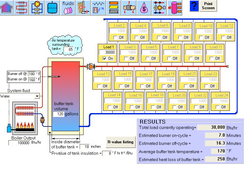So, my biggest mistake so far on building my own house is the lack of high temperature thermal storage. By high temp, I mean less than 200f.
taking up interior existing floor space is not an option. I was reluctant to go outside with an underground tank, but a valid option. I think that I found a way where I can dig horizontally from my boiler room into an existing crawl space under my family room. Extending between the footings could give me a tank 7 foot wide and as long as 18 ft, either 4 or 5 foot deep.
A 4x7x7 foot tank is 1466 gallons. an 18 ft tank would be about 3770 gallons.
The peak heat load of my house is about 100 MBH, but its the low load days, like 30 mbh that I have a problem with now because the boiler cant go that low (efficiently).
BTW, this is no small project excivating by hand and carrying out in buckets so a minimum size would be preferable.... but, i usually dont do anything minimum.
How Big?
thanks for your help
taking up interior existing floor space is not an option. I was reluctant to go outside with an underground tank, but a valid option. I think that I found a way where I can dig horizontally from my boiler room into an existing crawl space under my family room. Extending between the footings could give me a tank 7 foot wide and as long as 18 ft, either 4 or 5 foot deep.
A 4x7x7 foot tank is 1466 gallons. an 18 ft tank would be about 3770 gallons.
The peak heat load of my house is about 100 MBH, but its the low load days, like 30 mbh that I have a problem with now because the boiler cant go that low (efficiently).
BTW, this is no small project excivating by hand and carrying out in buckets so a minimum size would be preferable.... but, i usually dont do anything minimum.
How Big?
thanks for your help



 You can see how powerful the math is before pulling the trigger. Any way to widen the delta t on the tank for more capacity. 190- 200 draw down 60 degrees?
You can see how powerful the math is before pulling the trigger. Any way to widen the delta t on the tank for more capacity. 190- 200 draw down 60 degrees?